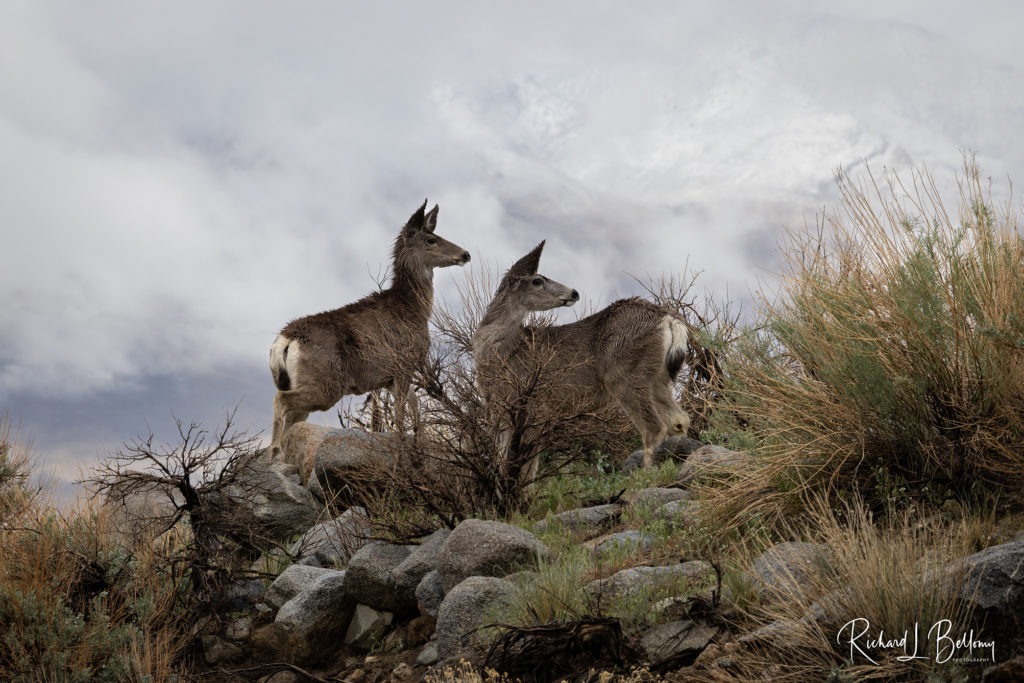This story was first published by Western Outdoor News in their 2/24/23 issue.
The Round Valley mule deer herd is preparing for a long journey. Twice each year, the
herd migrates between its winter range in Round Valley near Bishop to its summer range
in the meadows of the High Sierra.
The herd travels on the same paths each year, forming a migration corridor. Their route is
perilous, each journey through the corridor exposing the herd to new and continuing
threats to their survival.
On Sunday, March 19th from 10am -12pm, Eastern Sierra Land Trust (ESLT) is hosting
a public field trip to explore a portion of the Round Valley herd’s migration corridor.
Daniel Taylor, Human Wildlife Conflict Scientist with the California Department of Fish
and Wildlife (CDFW), will share stories and information about the region’s deer herd as
the group admires spectacular valley views and searches for wildlife. ESLT staff will also
discuss the organization’s land conservation work in the migration corridor.
Journeying Along the Mule Deer’s Migration Corridor
The herd spends the lean months of winter in the moderate climate of Round Valley, a
relatively small winter range of only about 30 square miles at the foot of Mt. Tom near
Bishop. During their time in the valley, the mule deer forage primarily for sagebrush and
antelope bitterbrush.
As winter turns to spring, the herd prepares to migrate to their summer range among the
alpine meadows of the High Sierra. This north-south migration has been closely studied,
as human roadway development and other factors have made the route increasingly
perilous.
The most hazardous portion of the Round Valley herd’s migration route occurs near the
community of Swall Meadows by the top of the Sherwin Grade. As they pass by Swall,
their route bottlenecks, with Wheeler Crest rising dramatically to the west, the Owens
River Gorge dropping off to the east, and Highway 395 running in between. A significant
number of deer-vehicle collisions occur each year in this bottleneck.
Challenging winters, raging wildfires, droughts, and additional human development are
among the other factors that increase the perils of the herd’s migration route.
Concerned Citizens Come Together
Concerned by the effect that human impacts and increased development would have on
the deer’s annual migration, a group of residents came together in 2001 and formed
Eastern Sierra Land Trust. Although the organization’s conservation work has expanded
since then, it continues to work to protect the migration corridor of the Round Valley
herd.
To balance the needs of people and wildlife, ESLT partners with willing landowners and
state and federal land managers to develop voluntary land protection agreements known
as conservation easements. In this way, local families and agencies permanently protect
important wildlife habitat by restricting future subdivision, while keeping their land
private and retaining ownership.
Since 2001, ESLT has worked with willing landowners and agencies to protect over
21,000 acres of land in the Eastern Sierra. Of those protected lands, 445 acres are in the
Swall Meadows area, and 176 of those acres were owned and managed by ESLT who
donated it to the California Department of Fish & Wildlife as a wildlife preserve, and 269
acres are privately owned. Swall Meadows is a key point in the migration corridor and the
permanent land protection has made the Round Valley herd’s passage safer, and forage
along the way more assured.
Get Onto the Land
ESLT is inviting the public to join their Mule Deer Migration Corridor Field Trip on
March 19th. The field trip will explore the Round Valley herd’s winter range, and offers
an excellent opportunity to enjoy the scenery of the Eastern Sierra while observing
wildlife and talking with a wildlife expert.
The trip will be led by CDFW Scientist Dan Taylor and will delve into information about
the migration corridor, mule deer behavior, and the work that goes into protecting the
iconic Eastern Sierra species. Eastern Sierra Land Trust staff will be present to answer
questions and discuss the organization’s land conservation work along the herd’s
migration corridor.
Also, hear updates on the Mammoth Lakes 395 Highway Crossing project. The crossing,
when completed, will consist of a series of highway undercrossings, overcrossings, and
exclusionary fencing near the town of Mammoth Lakes, and will significantly reduce the
occurrences of wildlife-vehicle collisions in the bottleneck of this herd’s migration route.
This free event is open to all ages and will run from 10am-12pm. For more event
information, including how to RSVP, please head to www.eslt.org/events or call (760)
873-4554.
About Eastern Sierra Land Trust
Eastern Sierra Land Trust is a nationally accredited land trust based in Bishop, CA.
ESLT works with willing landowners to protect vital lands in the Eastern Sierra region
for their scenic, agricultural, natural, recreational, historical, and watershed values. To
learn more about this non-profit organization’s work and how to get involved, visit
www.eslt.org.


















